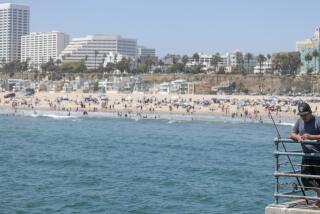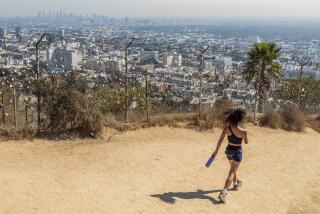August Was an Autumnal Illusion
The merchandise isn’t all that’s brief this summer at Akbar Afredi’s bikini stand at Venice Beach. Summer itself has been on the skimpy side.
“The weather has been cool and nobody’s been buying,” said Afredi, who during past summers sold as much as $800 in bikinis on a single hot day. This summer, he has gone home at night more than once after selling only one or two swimsuits.
“Cool weather is fine for the wintertime, but not the summer,” he said last week as he marked down his stock, hoping to clean out his 320-suit inventory over the Labor Day weekend--the traditional end of the summer season.
But despite the goose bumps that this summer has given Afredi and other sun lovers, the past August on average was only a few degrees cooler than normal in Los Angeles.
“We tend to remember the most recent weather,” said meteorologist Rick Dittmann of WeatherData Inc., which provides forecasts for The Times, “so if it’s been persistently cool for a few weeks, we say, ‘Gosh, it’s been a cool summer.’ ”
As if to underscore the point, the mercury took a sharp climb Saturday, registering 86 degrees in downtown Los Angeles. Forecasters predicted that the temperature would reach 90 Sunday and Monday.
Still, cloudy morning weather during much of August kept Los Angeles from warming like it usually does each afternoon, Dittmann said. The average high temperature at the Civic Center during the month was 81.3 degrees, compared to a normal maximum reading of 83.7 degrees.
The “normal” temperature is calculated on the basis of 30 years of readings collected in Los Angeles between 1951 and 1980.
But, temperatures notwithstanding, it has often felt different, autumn-like even, for spells this summer, and this in part is because of morning cloudiness caused by a low-pressure trough that extends from Alaska to Southern California. The low-pressure area, about 700 miles west of California and about 20,000 feet up, forms a thick cloud bank--known as the “marine layer”--at sea level that is pushed inland during nighttime and morning hours, he said.
“That gives the sun less time to heat everything up during the day.”
Last Friday, there were only about 500 people at Zuma Beach west of Malibu. Los Angeles County Lifeguard Lt. Roger Smith said a normal hot day would have lured up to 60,000.
“Attendance has dropped off the last few weeks. Lots of days, we could shoot a cannon down the beach and not hit anyone,” he said.
More to Read
Sign up for Essential California
The most important California stories and recommendations in your inbox every morning.
You may occasionally receive promotional content from the Los Angeles Times.











